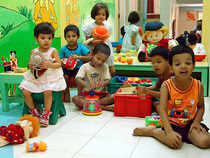
Two years ago, when Sharon Thomas became a father and was planning to move from Bengaluru to Mumbai for a better job, his main criteria was that the company should have a crèche facility. Since Thomas and his wife don’t have family living with them, they decided that one of them should land a job in a company with daycare. Thomas’ wife joined a software firm in Mumbai, and Thomas, an MBA and B Tech, opted for a leadership role at Johnson & Johnson (J&J), which had a daycare facility within the office building. Thomas has been using J&J’s crèche facility ever since he joined the company in September 2016.
“So far it has worked beautifully. I can go down to the crèche and check on her whenever it’s required. Initially, my mother-in-law had to come with us for about 10 days to ensure our daughter adjusted to the teachers. She settled in after about a month,” said Thomas, 35, HR leader for pharma business at J&J India.
Although daycare centres provided by organisations are primarily meant for women employees, a growing number of male employees are using these facilities too. The trend has emerged with men shouldering more household responsibilities in dual-income urban households.
Filmmaker Karan Johar, who is a single parent, has even opened a crèche inside his Dharma Productions office in Mumbai so that he can spend more time with his twins Yash and Roohi. All Dharma employees – male and female – can use the crèche.
Not everyone has that luxury but they do rely on company facilities. According to a survey by ProEves, which provides childcare, maternity and parental support solutions to companies, 70% of organisations provide in-house crèche facilities or access to a crèche to both male and female employees. The survey covered 70 companies.
Ketika Kapoor, co-founder, ProEves, said, “From our conversations with companies on their daycare strategy, we have observed that there is equal usage by women and men employees of on-site daycare. This is in the right direction towards equal parenting responsibilities.”
Hindustan Unilever, Asian Paints and Johnson & Johnson (J&J) have extended these facilities to male employees. Indrajeet Sengupta, HR head, J&J, said, “We have a crèche in our office building and it’s almost full. While the largest number of users is women, we see a growing interest among male employees wanting to use the facility.”
An HUL spokesperson said the company had seen a rise in the utilisation of crèche facilities by male employees over the last four years. “We encourage policies that support work-life balance like agile working and flexibility,” the spokesperson said.
The two in-house facilities at Asian Paints are used by both male and female employees. Emrana Sheikh, VP (HR), Asian Paints, said, “With the rise in nuclear families, it has become more important for organisations to provide a support ecosystem that caters to the needs of working parents.”
J&J’s Sengupta said their focus was on building an inclusive workplace. “If men don’t participate in diversity and inclusion conversations, it won’t work,” he said. J&J recently announced two-month paternity leave support for fathers. In another ProEves survey, most fathers (out of 100 covered) said the appropriate paternity leave would be between two weeks and two months (a median of three weeks). “We are helping companies launch paternity support programmes to help them through this new phase,” said Kapoor.
No comments:
Post a Comment